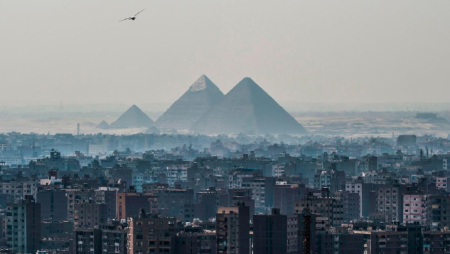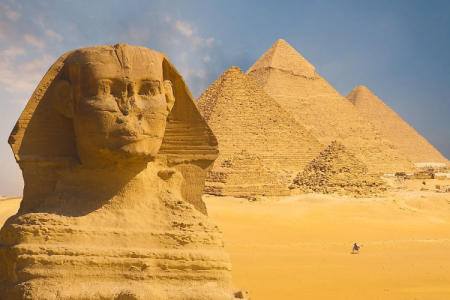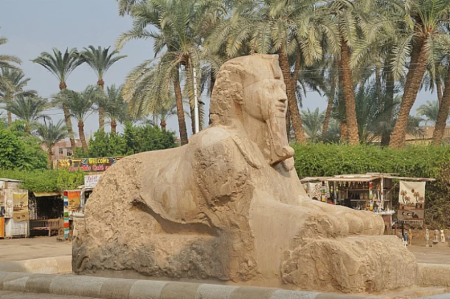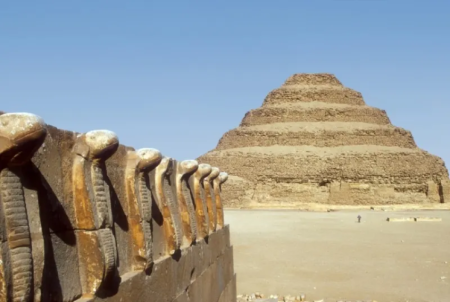Sphinx Statue

The Eternal Guardian of Egypt: Unveiling the Mysteries of the Sphinx Statue
Standing like a sentinel at the edge of the Giza Plateau, the Sphinx Statue is more than a colossal limestone figure—it’s a timeless enigma sculpted into the heart of Egypt’s desert sands. With the body of a lion and the face of a pharaoh, this ancient marvel embodies the power, wisdom, and mystery that have fascinated travelers, historians, and archaeologists for centuries. The Great Sphinx of Giza remains one of the most recognized symbols of ancient Egyptian civilization, representing both its architectural genius and its spiritual depth.
Carved directly from bedrock, the Sphinx Statue has endured the scorching sun, fierce winds, and the relentless passage of millennia. Its stoic gaze toward the rising sun evokes a sense of divine guardianship over the necropolis that includes the Great Pyramids of Giza, serving as a monumental fusion of mythical symbolism and royal propaganda. For those drawn to Egypt’s ancient wonders, exploring the Sphinx is a cornerstone experience that bridges the earthly and the eternal.
From afar, it appears as a silent observer of history. Up close, its weathered form tells a story of artistry, faith, and resilience. Whether you’re an archaeologist tracing dynastic secrets or a curious adventurer captivated by its grandeur, the Sphinx Statue offers an immersive journey through Egypt’s past—a journey that’s as breathtaking today as it was in the age of the pharaohs.
Origins and Construction of the Great Sphinx Statue
The Great Sphinx Statue dates back to approximately 2500 BCE, during the reign of Pharaoh Khafre of Egypt’s Fourth Dynasty. Scholars believe the face of the Sphinx bears the likeness of Khafre himself, symbolizing royal power merged with divine strength. The statue, carved from a single limestone ridge, stretches about 73 meters long and stands over 20 meters high. Its immense scale and precision reveal the technical mastery of ancient Egyptian craftsmen.
The exact purpose of the Sphinx remains debated. Some historians claim it served as a spiritual guardian protecting the pharaoh’s tomb, while others suggest it represented the solar deity Ra-Horakhty, connecting the earthly realm to the divine. Its eastern orientation aligns with sunrise—an intentional design that underscores its cosmic and religious significance.
Visitors exploring the Giza Plateau often combine their visit to the Sphinx with tours of nearby monuments like The Grand Egyptian Museum and The Valley Temple, enriching their understanding of the architectural and spiritual landscape surrounding the statue.
Symbolism and Cultural Significance of the Sphinx Statue
The Sphinx Statue embodies a compelling blend of human intellect and animal strength. In ancient Egyptian symbolism, the lion denoted power, while the human face represented wisdom and divine authority. This combination created a powerful icon of protection and balance—a guardian bridging the mortal and divine worlds. The Sphinx was more than a sculpture; it was a cosmic symbol linking heaven and earth, eternity and mortality.
Throughout Egypt’s dynasties, similar sphinxes emerged to guard temples and sacred avenues. The most famous example is The Avenue of Sphinxes in Luxor, connecting the Karnak and Luxor Temples. These guardian sculptures reinforced the belief that divine power watched over sacred places, warding off evil and ensuring harmony in the afterlife.
The Enigmatic Face of the Sphinx
One of the Sphinx Statue’s enduring mysteries lies in its face. While many scholars agree it portrays Pharaoh Khafre, erosion and ancient defacement make absolute identification difficult. The nose and ceremonial beard are missing, likely destroyed by natural decay and later iconoclasm. Interestingly, fragments of the beard now rest in museums, including the British Museum and the Cairo Museum.
The sculpted features—high cheekbones, broad brow, and serene expression—reflect the artistic ideals of the Old Kingdom. They also serve a deeper purpose, embodying the pharaoh’s eternal vigilance. To stand before the Sphinx is to gaze into the visage of divine kingship itself, carved in stone and set against eternity.
Rediscovery and Modern Excavations
Over thousands of years, shifting desert sands nearly buried the Sphinx Statue. Ancient records suggest it was excavated several times, most notably during the reign of Pharaoh Thutmose IV, who erected the Dream Stele between its paws. This granite monument recounts how the young prince fell asleep in the shadow of the buried Sphinx and dreamt the great guardian promised him kingship if he freed it from the encroaching sands. True to his word, Thutmose unearthed the monument and became pharaoh, forever linking the Sphinx with divine destiny.
Modern excavations in the 20th century revealed more about the statue’s construction, erosion patterns, and potential hidden chambers beneath it. Although many legends claim it guards secret tunnels leading to the pyramids, scientific studies have yet to confirm such passages. Still, the allure of hidden mysteries keeps explorers returning to this ancient wonder.
The Sphinx Statue and Egyptian Mythology
Within Egyptian mythology, the Sphinx Statue stands as a manifestation of solar and protective deities. It’s associated with Horus, the falcon-headed god of kingship, and often linked to Ra, the sun god. The statue’s alignment with the sun’s path reinforces its sacred relationship with cosmic order—what Egyptians called “Ma’at,” the principle of harmony that governed the universe.
The Sphinx’s silent gaze toward the horizon captures the eternal cycle of life, death, and rebirth. In many interpretations, it symbolizes the pharaoh’s transformation from mortal ruler to divine protector, a bridge between humanity and the gods.
Preservation and Restoration of the Sphinx Statue
The Sphinx has faced immense challenges over time—erosion, pollution, and misguided restoration attempts. Early repairs using cement mixtures caused more harm than good, cracking the fragile limestone. Only in recent decades have experts applied advanced conservation techniques to stabilize the structure. Laser scanning, 3D mapping, and geological analysis now help monitor its condition and prevent further deterioration.
Egyptian authorities, in collaboration with international archaeologists, continue these preservation efforts. These projects not only protect the monument but also enhance tourism experiences for those visiting Cairo Day Tours or booking Egypt Travel Packages that feature the Giza Plateau. Each restoration breathes new life into a monument that has already outlived empires.
Visiting the Sphinx Statue: What to Expect
Today, the Sphinx Statue welcomes millions of visitors annually. Standing at the base of the Giza Plateau, it offers stunning photo opportunities, especially during sunrise and sunset. Visitors can explore the surrounding temples, including Giza City and the Valley Temple of Khafre. The nearby Sakkara Necropolis and Memphis Egypt, the old Egyptian capital offer additional glimpses into ancient craftsmanship and funerary traditions.
Guided tours often include expert commentary on the Sphinx’s religious symbolism, historical context, and recent archaeological findings. For the best experience, travelers are encouraged to arrive early in the morning to avoid crowds and capture the Sphinx in soft golden light—a scene that feels frozen in time.
Legends and Theories Surrounding the Sphinx
The Sphinx Statue’s allure stems not only from its grandeur but also its mysteries. Some fringe theories suggest it predates the Fourth Dynasty, pointing to water erosion patterns that could indicate an older origin. Others link it to lost civilizations or astronomical alignments tied to the constellation Leo. While mainstream Egyptology attributes the monument to Khafre’s reign, the debate fuels endless fascination and scholarly discourse.
Legends abound—stories of hidden chambers, curses, and secret tunnels connecting it to the pyramids. The absence of definitive evidence only deepens the statue’s mystique, ensuring the Sphinx remains one of the world’s most captivating enigmas.
FAQs About the Sphinx Statue
1. Who built the Sphinx Statue?
Most Egyptologists credit Pharaoh Khafre of the Fourth Dynasty as the builder of the Sphinx Statue. The facial features closely resemble statues of Khafre discovered nearby, and its location aligns with his pyramid complex.
2. What does the Sphinx symbolize?
The Sphinx symbolizes strength, wisdom, and divine protection. It represents the pharaoh as both a powerful ruler and a guardian of sacred spaces, merging human intelligence with the ferocity of a lion.
3. How old is the Sphinx?
The Sphinx dates to around 2500 BCE, making it more than 4,500 years old. Some alternative theories propose it’s older, but no conclusive evidence supports that claim.
4. Can visitors go inside the Sphinx?
Currently, the Sphinx’s interior is not open to the public. Archaeological studies reveal small cavities and tunnels beneath, but these remain restricted for preservation and safety reasons.
5. What’s the best time to visit the Sphinx Statue?
The best time to visit is early morning or late afternoon, when the sun casts dramatic shadows highlighting its features. Pairing the visit with nearby attractions like Egypt Nile Cruises or Egypt Luxury Tours enhances the experience, offering a complete immersion into Egypt’s ancient splendor.











